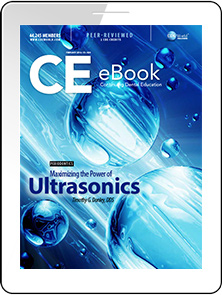Maximizing the Power of Ultrasonics
Released: Tuesday, February 16, 2016
Expires: Thursday, February 28, 2019
By Tim Donley, DDS
Commercial Supporter: Parkell
From early in recorded history, evidence attests to a human zeal to scrape off accretions on the teeth. Contemporary hand instruments for removing obvious deposits developed from their primitive precursors and eventually became the so-called gold standard for debridement. Indeed, the basic design of these instruments has changed only minimally over the centuries. More recently, however, a better understanding has emerged of the bacteria that initiate periodontal destruction. They take the form of a biofilm that often cannot be seen or felt with traditional hand instruments. To disrupt this biofilm and resolve periodontal inflammation, ultrasonic instrumentation arguably presents the most effective tool available to clinicians. This article reviews the insights into the etiology of periodontal disease and discusses the proper use of ultrasonic instrumentation.
LEARNING OBJECTIVES:
-
Define biofilm and explain its etiology.
-
Discuss the role of inflammation in the relationship between oral and overall health.
-
Describe how to best interrupt the biofilm that triggers periodontal disease.
-
Explain the theory behind the new goal of debridement.
About the Author
Dr. Donley is a leading expert in the treatment of gum disease and dental implants. A sought-after international speaker, he co-authored the first-ever textbook (used in dental schools throughout the world) on modern ultrasonic treatment for gum disease. Dr. Donley graduated from the University of Notre Dame and Georgetown University School of Dentistry, and completed his specialty residency at Indiana Medical Center in Indianapolis. He maintains a private practice in Bowling Green, Kentucky.
